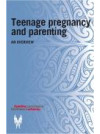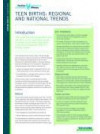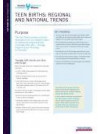This overview report responds to a Ministerial request that the Families Commission undertake research on two distinct questions:
- What are the reasons behind high rates of teenage parenthood amongst young teenagers in specific regions of New Zealand?
- What would discourage second or repeat teenage pregnancies?
This overview answers these questions and draws on the key findings from our full reports on regional statistics on teenage parenthood; Māori teenage pregnancy and parenthood; and a literature review on repeat teenage pregnancy.
In high-rate regions, the rates of teen motherhood can be explained by the socioeconomic and demographic characteristics of the region. These regions have areas of relatively high socioeconomic deprivation. They also have larger Māori teenage populations. Māori have a higher rate of fertility than the general population and this holds for Māori teenagers. There is much variation of rates within regions and targeting interventions by region rather than focusing on communities within these regions may lead to inefficient use of limited resources. Some high-rate regions have low populations and therefore low numbers of teenage parenthood.
New Zealand has many elements of an effective system of support for preventing repeat teen pregnancies, but there are gaps. The research identified a need to build more deliberate connections to make better use of current resources and to provide teen parents with supported alternatives that build on their aspirations, including:
- a stronger focus on relationship education and ongoing contraceptive advice for two years after the birth;
- support for transitions to education, training or sustainable employment.
- access to coordinated social services that respond to their complex needs
- connected local networks focused on teenage pregnancy and parenthood that can be replicated through out New Zealand
- valuing and understanding cultural needs for Māori teen parents
- inclusive and responsive services aimed at the needs of teen fathers as parents.
Key Results
Trends for teenage motherhood in New Zealand:
- To March 2011, 4,374 women under 20 years gave birth; of these, two-thirds were 18 and 19 years. Although the total teenage birth rate increased between 2002 and 2008, fertility rates and births have fallen slightly since 2009.
- There are some differences between and within regions in the rate of teenage motherhood.
The five highest rate regions: Gisborne (6.8 percent), Northland (6.5 percent), Bay of Plenty (5.6 percent), Hawkes Bay (5.5 percent) and Manawatu-Whanganui (5.4 percent). There are quite large differences in rates within many regions. For example, within the Bay of Plenty region one territorial authority has a rate of teenage motherhood of 7.8 percent, whilst another territorial authority has a rate of 3.9 percent. - Although the rates in these regions are high, actual numbers are sometimes quite low because they have low populations.
Approximately 30 percent of births to teenage mothers in New Zealand occur in the Auckland region. It is important to consider numbers as well as rates when analysing by region. This has implications for funding and service provision. - The rate of teenage childbirth and motherhood for high-rate regions strongly correlates with socioeconomic conditions and the ethnic composition of the region.
Both ethnicity and socio-economic (SES) circumstances appear to influence region rates; Māori teenage women have higher rates of fertility even after controlling for socio-economic factors. Nationally, teenage fertility rates are significantly higher in areas of high socio-economic deprivation, and these regions contain communities with relatively high levels of deprivation.



